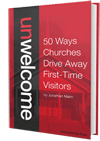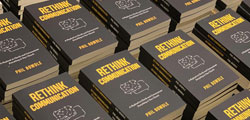Decades ago, church was a place your family had attended for generations. Today, people relocate for jobs, college, adventure and a thousand other reasons, and find themselves “shopping” for a new one.
While visiting churches in their new area, they may spend one Sunday at yours. The impression they get that morning is how they’ll decide to come back or not… unless you find a way to give them a bigger picture—like e-mail.
How E-mail Can Bring Them Back
The trick is creating something called a follow up series: a set of auto-delivered e-mails sent to new subscribers, designed to get visitors comfortable with your church.
Follow ups are easy to create if you use an e-mail marketing service that provides pre-designed e-mail templates. You can just drop your content in and specify how many days you’d like to go by between messages.
Then every new visitor will receive all the details you’d like to share about your church. That is, after you get their e-mail addresses.
Getting Their Addresses
Most likely, you already have a method in place to welcome first-time visitors.
If you have assigned greeters, encourage them to find out if visitors are just passing through or if they’re looking for a new church. If they’re church-shopping, have the greeters ask if they’d mind getting a few e-mails with more information about your church.
If you use welcome cards and have people fill out their information, make sure to include a note on the card that they’ll be getting e-mails about the church, or if you want to e-mail them on a personal basis, have a box they can check if they’d like more information.
Then you can send them e-mails.
What to Put In Your Follow Ups
After you’ve thanked your visitors for stopping by, you’ll want to give them information to make them feel as welcome and comfortable as possible, while at the same time, representing your church accurately. You may want to send:
- Greetings from your church leadership, with pictures so they can recognize a familiar face if they return.
- Service, small groups and Sunday School schedules.
- Stories of what God has been doing in your church.
- Details about upcoming events (or where to find that info—if you truly automate this process, you want to use content that doesn’t have to be updated every few months).
- Opportunities to volunteer.
- Baptism and membership procedures.
Note that you’ll want to keep the series short. Even if it takes a while for someone to choose a church, you should be able to give them a good idea of your church’s attitude, beliefs and practices within a few messages. (Plus, if they’ve ruled your church out, you don’t want them reporting you as spam. Be sure to include an unsubscribe notice—most e-mail services do this automatically.)
Moving Forward
Those who do choose your church as their regularly scheduled service, however, may want to keep getting e-mails from you.
If you already send weekly broadcasts to your congregation, you’ll just have to add your new recipients. You can either ask in person if they’d like to be added, or you can send them an invitation to subscribe to those e-mails. You could also include a subscribe option in your last follow up e-mail.
With an auto-response follow up series you’re giving one-time visitors a reason to come back.
 More:
More:
- Learn more about how to welcome church visitors with this massive collection of resources and blog posts.
- Walking into a church for the first time can be scary. Check out Unwelcome: 50 Ways Churches Drive Away First-Time Visitors by Jonathan Malm for practical ideas and perspective on first-time guests.





Matt
September 19, 2011
I cringe at the term “auto-response.” Auto-response emails are an automatic delete in my inbox; I’m sure they are in a lot of other people’s too. I can find all the information I want about a church online. What I’m looking for when visiting a church is a personal connection that goes beyond information.
Marc Aune
September 19, 2011
I tend to agree with Matt that automated emails are often an automatic delete for me, but at the same time I should expect to get emails if I supply my email address. If a church tries to be sneaky about acquiring the information and then bombards the visitor with unwanted emails, that’s one thing. But, if a church is transparent about how a visitor’s contact information will be used, it shouldn’t be a big deal. It’s important to give the reason for requesting an email address—we want to tell you more about our church—if you’re going to ask for it.
Nathan Creitz
September 19, 2011
I agree with both of you (Matt and Marc). An email gives a first time guest some valuable info that might help them make up their minds about whether or not to come back. The good news is, if they’ve taken the time to come through the doors, fill out a card, and provide their email, they are literally asking you to give them more info.
On the other hand, an email cannot be the only follow up strategy. It’s time to get out from behind the computer and take someone out for coffee to get to know your new neighbors!
Sam Williams
September 19, 2011
This is – beyond a doubt – the worst idea for a first time visitor. Could this be any more impersonal? Did you actually say it was a “set-it-and-forget-it” mule? This is the problem with the church today. Cold and impersonal. I would never go back to a church that sent me something like this.
Michael Buckingham
September 19, 2011
Why the need for an auto-responder? Because it’s easy? Bad reason. Because you have 10,000 people that want to stay updated? Ok.
Most churches don’t have a good reason that someone can’t respond personally to these emails.
I know that probably sounds crazy. But pause for a second.
We are in a digital age. We communicate digitally.
What if people always talked to machines when they called, computers that could respond based on what you said? Ludicrous…but that’s often what an auto responder is.
So don’t go to that as your first solution. Find a way to make it personal. If you do, you’ll start to build a relationship and if you do that you’ll need to send out an email talking about your building program to fit all the people.
Wayne
September 20, 2011
I’m for the church using every available resource to reach out to people. Some people do read email, even if it’s “auto response.” I know when my church sent me my first email, I was excited to receive it and it was automatically generated. So churches, I say go for it. What do you have to lose? If the worse thing they can do is delete it, then what’s the harm?
PatrickC
September 22, 2011
I agree that auto generated mail sometimes may not be personal but I would say it is a good starting point. If the recipient responds to the automated message then it should be a personal reply
Damian
May 1, 2012
As was stated, the concept of auto-responder email is good. It has been proven effective repeatedly in the for-profit world, because it can build trust. However, most implementation in secular and non-secular of auto-responders is terrible. Just as a greeter at a store can totally change the experience for the better or sink the relationship with the whole chain, so can poorly written email generic auto-responders. A poorly written email auto-responder can seem like a chain letter or worse.
There is a reason why communications professionals will write 50 drafts to get the best chance to communicate the intended tone and message. Just like a minister will often spend much time writing a sermon to get it ‘correct’ and it still evolves through multiple services. Even the Bible has gone through a few revisions of the last few centuries to make sure its message and tone is unmistakable (perhaps it may not be done being revised to tell its story based on the number of interpretations of its messages).
I would recommend that we look at what has a longer history then email auto-responders for how to most effectively communicate with new relationships. Direct marketing studies decades ago realized that it took seven (from letters, TV spots, Radio or in-store visits) touches to get the optimum amount of interaction with a perspective person to solidify the relationship (relative to invested cost). New studies increase that to 9 or 11 touches with the increased onslaught of communications and greater sensitivity to building trust.
That is much of what is at issue here – trust. Does the new guest trust that you understand them? And do they trust they understand the ‘real’ congregation you represent? It becomes hard to trust that you understand someone who may not understand themselves (as may often be the case of shoppers/searchers). It becomes hard to trust, if they only meet a few people in a congregation. It becomes hard to trust if they don’t have a solid referral from someone they trust (especially if they are coming from a place that did have solid referrals and it did not work out). A congregation is where many people put more trust then most any other relationship they have (including family or spouses). Visitors may not know they are looking for a place to put that much trust, but often they are.
Have you earned that trust?
Look at how would you build trust with a new relationship in an off-line manner and consider how to translate it to written form. That may include some disclosure yourself and the congregation (when the annual meeting is, how the board is elected), but often not on the 1st touch. It may include offers to be inclusive, but just as you would not propose on the 1st date, you may not invite someone to lead a group in the 2nd email. The building of trust is based on a mutual exchange of signals that show commitment on both sides. If you don’t properly respond to a visitors signals you are being as rude as kissing someone who shows no interest in a physical relationship.
Of course in the age of digital tools like Constant Contact, iContact, HubSpot, InfusionSoft and many others, consider not creating a single one size fits all approach. Again the lessons and proof go back to the early days of direct marketing and have shown a segmented approach is best. Send a different series of letters to parents then young adults (possibly both if they are indeed young adult parents). The relationship of an empty nester will be different then many 30 year old divorcee’s.
If they overlap, consider staggering your send times. Don’t send them all on Mondays, send the parent letters/auto-responders on Wednesday, Young adults on Friday, etc.
Look at the rules of etiquette in similar online venues (online dating is probably the most clearly documented) and use them to create an appropriate method to build trust with new visitors and you will create many new relationships.
Auto-responders (multiple with proper spacing) can be a great tool in developing mutual trust in a new congregant, especially if it is integrated with personal touches along the way. Especially if it is show ing of the care you would take for a new parishioner. This is your chance to show you care. Does that not deserve a little more effort then 10 minutes for a one size fits all generic letter.